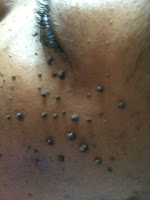 The growth of moles on the skin is totally normal. Some tend to go after years of growth and some remain permanently, although there is this one disease that can trigger an alarm, namely melanoma. When moles appear to change from its normal state, seek medical attention immediately for a diagnosis of melanoma.
The growth of moles on the skin is totally normal. Some tend to go after years of growth and some remain permanently, although there is this one disease that can trigger an alarm, namely melanoma. When moles appear to change from its normal state, seek medical attention immediately for a diagnosis of melanoma.How are melanomas formed?
Melanoma is a kind of cancer of the skin that happens due to accumulation of melanocytes that produces melanin. Melanin gives the ideal skin pigmentation and characteristic color. When the skin is exposed to sunlight, melanocytes tend to produce more melanin that may cause skin tan or further darkening. When melanocytes form in clusters, it produces benign growth that is known as moles. Moles are somewhat common because there are about 10-30 moles that people may have.
Some become pinkish, others brown and others in a similar way to the skin color of the person. If the person is dark, you can expect a dark mole. Some moles are small and others are about the size of a penny. The moles can be extracted at the preference of the person and once extracted, they will not grow anymore.
Melanomas will be formed the moment the mole shows any change in structure like size, color and shape. The feel of the mole existing on one part of the body will also be different. Melanomas can be easily recognized because of its characteristics. Melanomas appear as if it was an evolution of a mole which tends to look abnormal, blacker, and even uglier. Below are the ABC’s of melanoma signs and symptoms. If you see anything similar to what you have, then it is best that you see your doctor immediately in order to find the appropriate cure.
You have to watch out for the following changes:
A - asymmetry refers to the shape of the mole if it doesn’t match the other’s shape.
B - border refers to the edges of the growth that are unusually blurred, ragged, irregular and notched when it comes to its outline; some of the pigments spread by the surrounding area.
C - color is not even. There may be shades of tan, black and even brown on just one growth. Areas of red, blue, grey, white and pink are also manifested by melanomas.
D - diameter is an actual change in the size of the mole which is usually increased more than decreased. You can check if the growth is larger than a pencil eraser.
Base on the ABC’s, you can now diagnose your own mole, although melanomas tend to show majority of the ABC characteristic features and some show just one or two of it. It is advisable that one get skin examination at once when some of these signs and symptoms appear on one part of the skin.
Having a routine checkup is appropriate. If melanoma is diagnosed at an early stage, the chances of treatment are greater because the tumor has not yet penetrated deeply into the skin tissue. It must be remembered that when melanoma is not removed in its early stages, it will be more difficult for the person to control the spread in nearby tissues and body parts.
People who already have melanoma are also more likely to develop new moles that could trigger new melanoma growth.








